FARMINGTON — There was plenty of snow for 40 competitors participating Saturday morning in the first day of the two-day 11th annual dog sled races at Sandy River Farms.
However, it wasn’t the right consistency, so racing times were slower than usual, announcer Mary Ellen Cariso said. The temperature for the Down East Sled Dog Club event was 19 degrees at Bussie and Brenda York’s field beside Routes 2 and 27.
“The snow’s a little too fluffy,” she said, laughing. With more than 45 inches falling in the past 10 days while temperatures were near or below zero during storms and afterward, it’s been hard to pack the snow into a hard surface for sled runners.
“The trail crew has worked really hard, but (the trail) is really slower than we’d like,” Cariso said. “But it’s an equal handicap for the competitors. Today is a beautiful day for the spectators, but (conditions are) not ideal on the trail.”
Due to a light breeze that sent wind chills into the single digits to subzero range, many spectators sat in their idling vehicles parked along the east side of the starting gate. Others stood around a small bonfire beside the course.
“Everyone keeps saying, ‘Oh, you must be so happy with all this snow,’ but it’s tough and it doesn’t pack and it’s hard for the dogs,” said musher Jennifer Barnes, owner of TuffLace Kennels in Corinth. “And with the storms lately, you just get one cleaned up and you have to go for the other. You don’t get a lot of time with the dogs, actually, but we’ll take it.”
Racing began at 9:30 a.m. with three people participating in the 1-2 Dog Skijor. A person using Nordic skis is pulled along the winding 4-mile course by one or more dogs in this event.
Elaine Stasny took first place with a time of 20 minutes and 30.36 seconds; Amy Craves finished second at 24:01.51; and Geoff Shallard, using two standard poodles, took third at 41:52.
That was followed by the 4-Dog Pro or Adult Sled 4-Dog Speed Class race. The teams have staggered starts and race against time. Finish times on Saturday determined placement for Sunday’s races. Times for races on both days will be combined to determine winners competing for $2,800 in prize money.
Fifteen racers and their dog handlers hitched yipping, yapping, growling and whining dogs of varying breeds to harnesses and lines while the mushers stood on the sled brake and kept a firm grip on the sled handles. Overly energetic dogs leaping high in the air would yank on the sled.
It was a maddening cacophony that grew louder as Cariso called teams by bib numbers to the starting gate, because the dogs know they are about to hit the course, Barnes said.
“Thirty seconds, Jacob Turner, No. 4,” Cariso’s voice was amplified through a loud speaker attached to Joy Turner’s sport utility vehicle parked beside the start and finish lanes. The dogs even drowned out their generator, which powered a laptop computer, printer and timer.
“Fifteen seconds, 10, five seconds, 4, 3, 2, 1, go!” she said. Turner of Jay was launched down the course as a small crowd cheered. And every dog, including a lone beagle attached to a leash held by a spectator, started barking and jumping around uncontrollably.
“One starts (barking) and they all start,” Barnes said. “And they know the countdown, too. They act a lot different at a race than they do training. They know that countdown. They know the loud speaker. They’re crazy to go. They love to run.”
Barnes is in her 20th straight year of racing since the age of 12 or 13. She has nine dogs, mostly Husky or mixed with pointers and hounds.
“My dad always says, ‘There’s a lot of money in dog racing.’ I know, because I put it there,” she said. “It’s an expensive hobby, that’s for sure. I mean you feed them year round, and there’s the equipment, and you’re buying dogs and dog food.”
She races every weekend in the wintertime from January through the first week in March in Maine, New England and Canada. “I’ve done pretty good over the years, but this year is kind of a rebuilding year for me, but we still did pretty good. We did really well today, considering. We’re in fifth place and I’m thrilled with that.”
Keeping, feeding and training dogs year round is one tough hobby.
“It’s not like your usual hobby where when you’re done with it, you put it in the closet and don’t worry about it ’til next year,” Barnes said. “It’s every day, multiple times a day. It’s a lot of work, but it’s fun and you’re interacting with dogs all the time, so you’ve got to love dogs and you’ve got to love the cold.”
She said all dog breeds used for sled racing are good for different things.
“The Siberians — the malamutes, the big puffy dogs you see on TV — they’re great for pulling and going slow and easy and there’s some fast ones, too, all the way to pointers — the hunting dogs — that go really fast, but the cold is a little harder on them.”
Barnes raced Saturday in the four-dog sprint and will return Sunday to do it all over again.
Sunday’s events start with a drivers’ meeting at 8:30 a.m. followed 30 minutes later by the 1-2 Dog Skijor, the 4-Dog Pro sprint, lunch, the Kids’ 1-Dog sprint, 6-Dog Pro and 8-Dog Pro sprints.
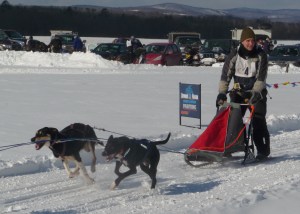
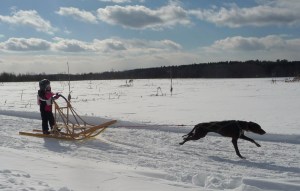

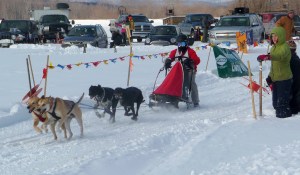
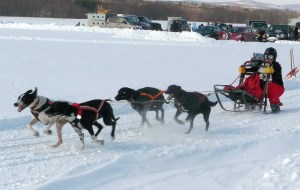
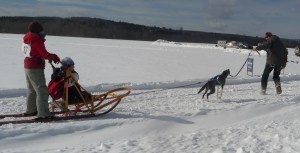
Comments are no longer available on this story